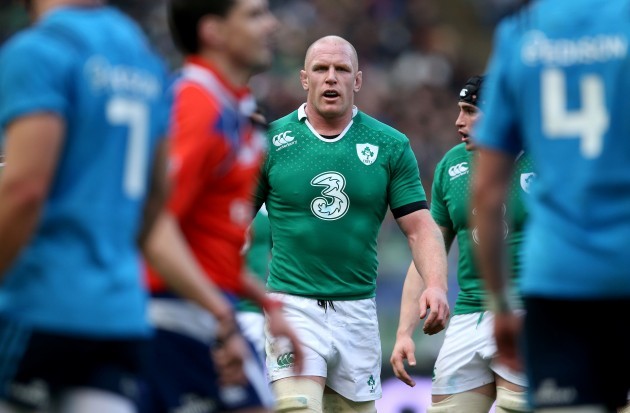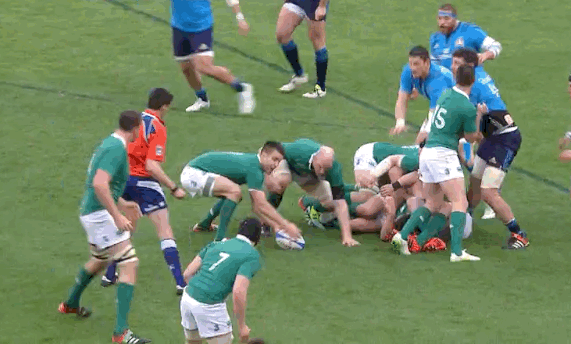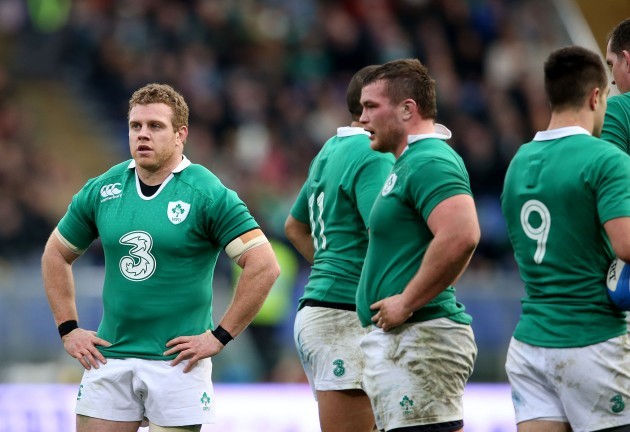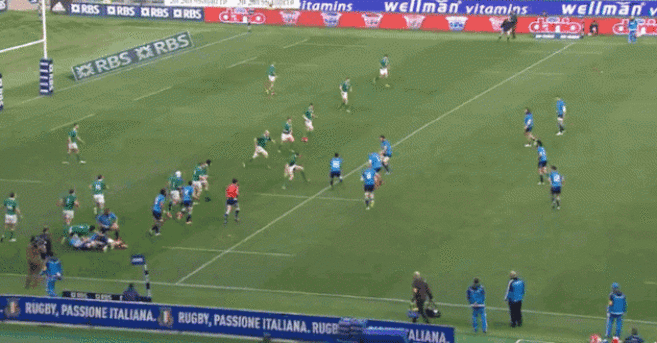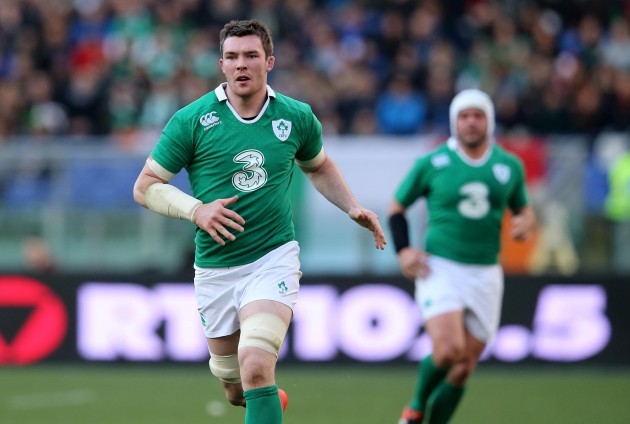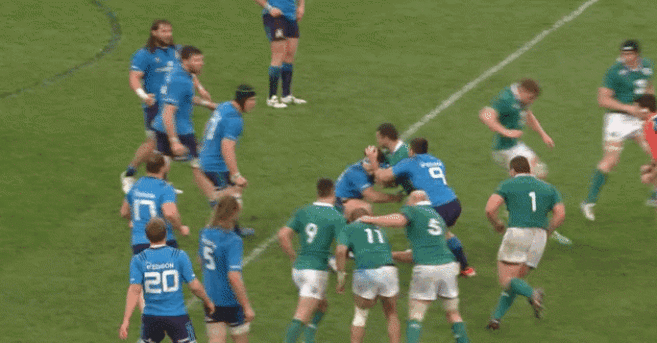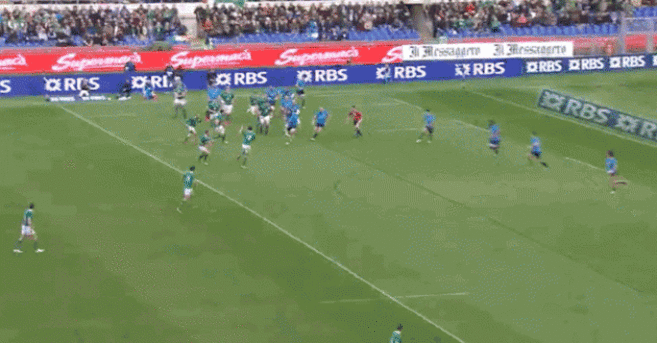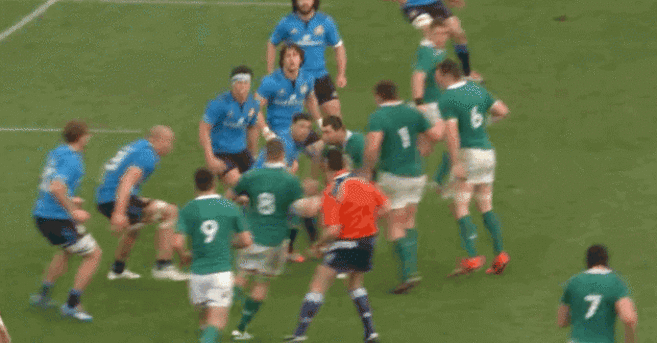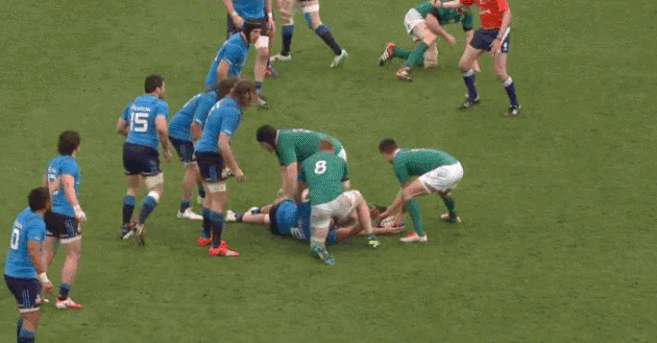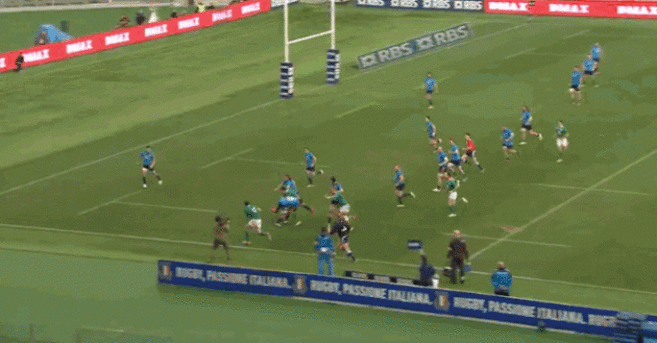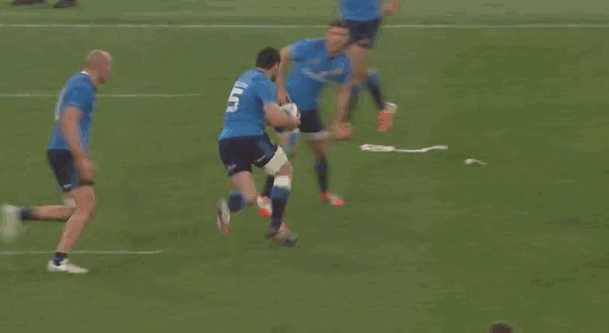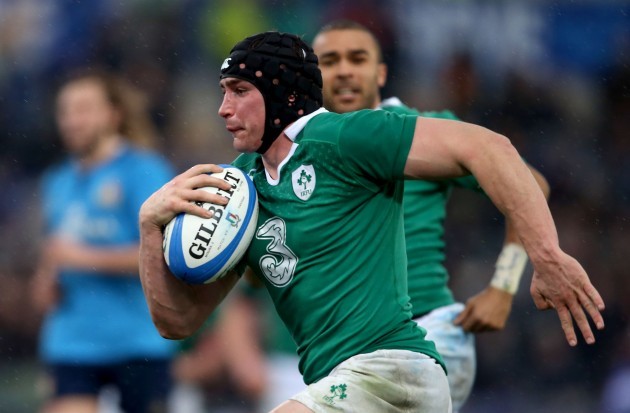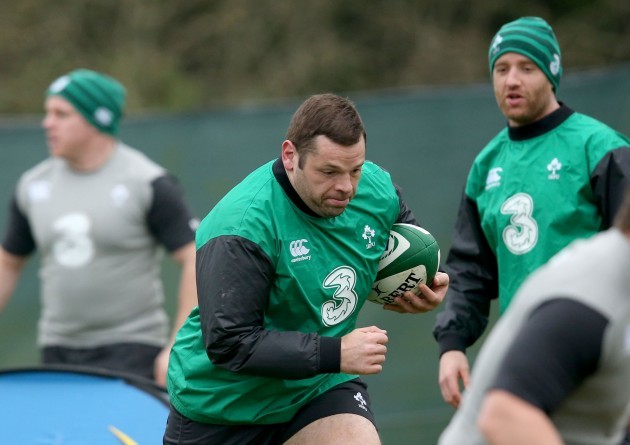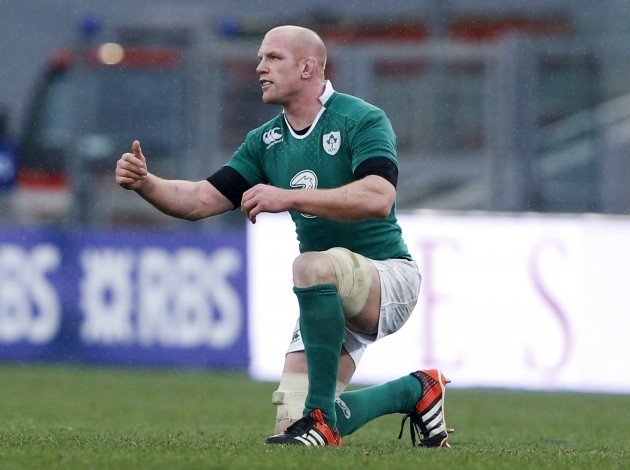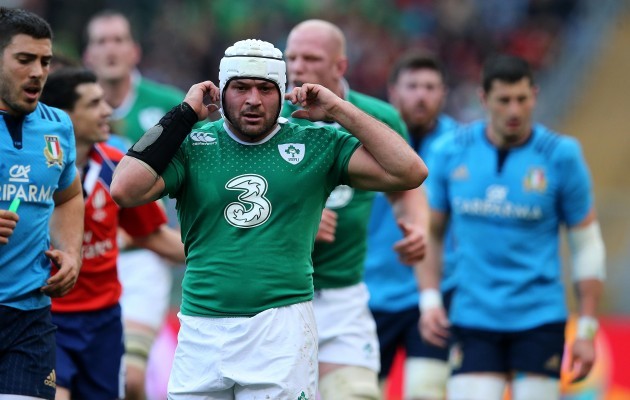WE DON’T NEED to tell you again how important winning the breakdown and ruck is in rugby.
Joe Schmidt is as focused on this area of the game as any other coach who wants to be successful, understanding as he does that losing the breakdown and ruck battle is a sure-fire way to lose an entire game.
Instead, let’s jump straight into what went on at the breakdown and rucks in Ireland’s 26-3 win over Italy in Rome on Saturday.
We carried out this type of analysis after Schmidt’s side beat South Africa in November and had hoped to do it more frequently, but were forced to put it on the back burner until now.
However, we will be carrying out this analysis on each of Ireland’s Six Nations games in 2015, meaning we should get a rounded picture of how effective the Irish breakdown and ruck work is, as well as helping us to understand who the key players are in this area.
As we mentioned in November, this analysis is heavily inspired by the magnificent ‘Ruck Marks’ articles done by the excellent Digging Like a Demented Mole blog.
What we’re looking at
For the purposes of this article, we’ve studied and noted every single action by the Irish players at the breakdown and ruck against Italy, both in attack and defence.
Just to recap, when we refer to the ‘breakdown’ here, we mean the situation in the split second after a tackle has been made and no ruck has formed. The term ‘ruck’ signifies the meeting of at least one player from each team over the tackle in a contest for the ball.
We’re going to use the same system as in November as we used for the piece around the South Africa match, which is detailed below. If you’re already aware of it, feel free to skip down to the section headed ‘An efficient force’
********************
When looking at Ireland’s rucking in attack, we have marked players in terms of their arrival to the ruck. That is, was the player first on the scene post-tackle, second, third, or even fourth?
It’s useful to know who was first to the breakdown in attack most often, but we also need to account for the quality of each player’s rucking effort too. Otherwise, we’re just left with a pile of arguably meaningless numbers.
Tommy O’Donnell was the first man to arrive to the breakdown on 17 occasions against Italy, but how effective was he once in position? Simon Zebo was the second Irish player into the ruck seven times, but did he make a difference?
In order to attribute quality to each rucking effort, we’ve gone for five degrees of competence - dominant, effective, guard, present and ineffective.
A dominant act of rucking signifies a moment where we actively think ‘that’s an exceptional clear-out.’ These incidences are quite rare, and involve cleaning a defensive player out extremely swiftly and powerfully, ensuring optimal quick ball. Removal of a major turnover threat would also generally qualify as dominant.
An effective rucking action is any one which effectively clears out a defensive player, in a less breathtaking way than the dominant category. It generally involves moving a body that is not an immediate and major turnover threat, but ensures quick attacking ball.
A guard action signifies a player who does not actually engage a defensive player, but is present at the ruck to guard the ball, discouraging the defence from attempting to make a steal.
The present marker is used to note any player who is involved in the ruck, but has no major effect on it either positively or negatively. It’s quite a vague label admittedly, but are so many different things that can happen in a ruck that it serves a purpose.
Finally, an ineffective marking indicates poor rucking from a player, whereby they perhaps failed to clear a turnover danger or were very slow to shift a body when that needed to be done.
As with so many other aspects of the game, rucking is a very complex and nuanced element. A brilliant clear-out can come in the form of smashing a defender off his feet as he looks to poach the ball, or using a tin-opener technique to roll them away when that is more ideal.
A poor rucking effort could see the attacking player allow a defender into position for a turnover, slide up their back and beyond them, fall off their feet too easily, not arrive with a strong base, or lack aggression in the hit, to cite a few examples.
That means that every dominant [or effective or ineffective] rucking effort is not of the same type. In that regard, you’re going to have to trust our judgement on these actions, or go back and watch the game in full yourself.
Defensively, we’ve gone with four categories to indicate the quality of the effort. A turnover means the player has won possession from the opposition, while a turnover assist signifies that another player may not have won the turnover without the assistance of that assisting action.
Slowing indicates that the defensive player has clearly done that to the opposition’s possession, while the present category is for a player that needed to be cleared away even though they were not involved in completing the tackle.
*This analysis of the Ireland v Italy match was undertaken through one set of eyes and over the course of a stop-start-rewind-pause-fast forward-pause viewing of the game. If there are any minor inaccuracies, for that we apologise.
An efficient force
As in November and their entire time under head coach Schmidt, Ireland were an effective rucking force against the Italians on Saturday. Among the 386 actions we accounted for, just 20 of them were ineffective.
That said, Schmidt would hope for more than eight dominant actions, even if 145 in the effective category will have been pleasing. What we’re saying here is that Ireland are good at rucking; they always have been under Schmidt and it’s likely to continue even when they face better teams like France and England.
Obviously Ireland place huge importance on retaining their own ball in the rucks, with 82 third-man arrivals and 19 fourth-man arrivals highlighting that once again.
Even if those third and fourth men weren’t always an absolute necessity, Ireland would commit an extra body if there was even the slightest hint of a turnover threat.
Oddly for a team including Paul O’Connell, Peter O’Mahony, Rory Best, Jack McGrath and Tommy O’Donnell, Ireland didn’t win a single traditional [ie. a jackal over the ball] turnover at the breakdown against the Italians.
Jordi Murphy did help to force one turnover at a first-half ruck, but it wasn’t the type of steal we’ve come to expect from Ireland. There were a number of instances when O’Connell looked particularly flummoxed not to get a turnover penalty, but referee Pascal Gaüzère gave the benefit of the doubt to the attacking team throughout this game.
With 205 rucks in the Rome clash, compared to 179 in the Wales v England fixture and 160 in France v Scotland, there was certainly a lot of rucking to be done, and a number of Ireland players racked up highly respectable figures.
O’Connell still motoring
With a total of 41 ruck involvements on both sides of the ball, captain O’Connell was the most active Irish player in rucking terms on Saturday, although there were others who had more effectiveness.
That’s not to say that O’Connell was all quantity and no quality. Indeed, the Limerick man had zero ineffective contributions at the ruck, while offering up one dominant smash and eight effective clear-outs.
O’Connell was first man on the scene nine times, arriving in second 10 times and being third arrival on a leading 11 occasions.
There were actually 22 guard involvements from O’Connell against Italy, although that shouldn’t be interpreted as laziness or inaction. The second row is always focused on ball security and his work rate and role allows him to get to more rucks than most players.
Defensively, O’Connell may have been somewhat disappointed not to poach some Italian possession, but two slowing actions showed his hunger to compete, while there were two present markings in his performance too.
All in all, a typically busy rucking performance from O’Connell tallied well with a solid outing around the pitch and in the set-pieces. There remains plenty of life in the 35-year-old warhorse yet.
O’Donnell steps up
Losing Sean O’Brien at such a late stage was naturally a major blow for Ireland, but Munster’s in-form openside Tommy O’Donnell comfortably switched from a bench role into the first team and performed well.
A second-half try was the highlight for the 27-year-old, but there was real quality in his rucking involvements too. A total of 40 actions in this area made it an extremely taxing afternoon in a physical sense, but O’Donnell’s fitness delivered.
The openside was top of the leaderboard in terms of first arrivals, with 17. Remarkably, 12 of those were effective and there were two dominant hits too. Of his 10 second arrivals, seven were effective, meaning O’Donnell gave a very strong display.
Defensively, the Cahir man was as the joint-leader in terms of numbers, as he made three slowing actions and had another three presents. The breakdown and ruck being such a central area for any openside, Schmidt was surely pleased with O’Donnell.
The competition in the back row for Ireland is such that O’Donnell’s chances have been limited, but he showed his value on his first Six Nations start in Rome.
A hungry, hungry Mike Ross
Next best in terms of all-round involvements for Ireland was Mike Ross, with all 37 of them coming when Ireland had possession of the ball. With just two racking as ineffective, this was a hugely impressive outing for Ross.
Having recently lost out to Marty Moore at tighthead with Leinster, the 35-year-old might have felt he had something to prove when Joe Schmidt kept the faith in him to start for Ireland.
Whatever it was, Ross was extremely driven against Italy, getting through an abundance of work in his 51 minutes on the pitch. The tighthead’s scrummaging display was also encouraging ahead of a bigger test against the French.
Ross was first man to the breakdown seven times versus Italy, but the real bulk of his work was done as second arriver, with a leading total of 17 in that category. Two dominant efforts and seven effective markings highlight how good Ross was at sealing the deal for Ireland at the ruck.
Any sign of a struggle for the first man, or a second defender hovering close to that precious ball, and Ross would very often arrive to blast them away and allow scrum-half Conor Murray to play the ball.
It can be tempting to wonder what Ross and other tightheads do when they’re not scrummaging, but between lifting at the lineout, making tackles around the fringes and hitting rucks, they’re as busy as any other player. Carrying 127kg of mass along the way means it’s no easy task.
Murphy, McGrath, Best and Toner at the races
Jordi Murphy’s work rate for Ireland in Rome was phenomenal as he carried the ball 16 times, made seven tackled and had 36 ruck involvements. He produced a turnover assist to help Murray rob Italian possession, while also slowing twice.
In attack, there were 10 first arrivals and 11 as second man in, while there was real quality in the majority of those actions too. Schmidt is a big fan of Murphy’s, and the numbers do underline why. More importantly, the qualitative markings are strong too.
Equally as in favour with Schmidt is lock Devin Toner, who was immense at the lineout in Stadio Olimpico, and remains a useful 124kg weight at scrum time. Rucking-wise, he is usually a big contributor too, and that was no different in Rome, with a total of 30.
The bulk of Toner’s rucking was as first or second man in, the most physically demanding of them all, and the 6ft 10ins Meath man continues to get better in this area of the game even at the age of 28.
Meanwhile, Jack McGrath had 34 involvements, no surprise for a player who truly excels at ruck time. The 25-year-old possesses excellent breakdown technique and adds real venom when he arrives at the point of contact.
Similarly, hooker Rory Best is an aggressive, no-nonsense ruck operator and to rack up 26 ruck involvements in 46 minutes on the pitch was impressive. The Ulsterman suffered a concussion in the 44th minute, but still managed to hit another eight rucks before play came to a halt, as pointed out by Rúaidhrí O’Connor yesterday.
Schmidt will hope to have a key rucking player fit again in time to face the French.
Finally, it was an oddly quiet rucking performance for Peter O’Mahony at blindside. Like O’Connell, the Munster captain will have been frustrated not to get any steals, but there were four defensive efforts in his total of 22 involvements.
There was no sense that O’Mahony wasn’t at rucks he should have been at, but for some reason or another, the breakdown of play didn’t appear to flow in his direction. It seems likely this outing was something of an anomaly.
Zebo king of the backs
With 22 total involvements at the ruck, left wing Simon Zebo led the way for the backs, arriving first an impressive nine times and second on seven occasions.
Seven effective hits when he arrived perhaps underline how the Cork man has improved in the areas of the game Schmidt has asked him to. There were still a handful of rucking efforts Zebo will look to improve, but this was hard-working stuff once again.
Robbie Henshaw and Jared Payne, with a total of 15 and 14 involvements each, were asked to contribute handsomely to the rucks and both did so with a pleasing element of efficiency.
Strangely for a fullback, Rob Kearney was similarly busy with 14 involvements, seven of them impressively effective, but that merely highlights the demands Schmidt places on his players in this area, regardless of positioning.
Tommy Bowe had a couple of outstanding contributions in his 9 total actions, particularly a dominant hit as second man in. Unsurprisingly, scrum-half Murray was the least active Irish starter in terms of rucks with only 2 involvements.
More notably, Ian Keatley hit 10 rucks, a large number for an out-half. It’s not the ideal place for an out-half to be, given they are the main director of the attack, so Schmidt will be keen to see Johnny Sexton avoiding reaching such a number against France.
Hendo leads the subs
Despite only getting 15 minutes on the pitch, Iain Henderson was joint-fourth for Ireland in terms of defensive rucking involvements [4]. That was mainly down to the Italians having their best spell of possession during that stage of the game, but even still the Ulsterman got a chance to show his ever-growing skill in this area.
Marty Moore also made his presence felt to keep the pressure on Ross at tighthead, racking up 7 involvements, five of which were effective. That’s a fine return.
Another man whose rucking was strong off the bench was replacement hooker Sean Cronin, who four effective actions among his total of 9. The Leinster front row is most renowned for his ball-carrying, but he too has strong rucking skills.
Schmidt accepts nothing less.
Top of the Pops
Below, we’ve listed the rucking involvements for each Irish player in the starting team and those who came off the replacements bench.
First arrivals
17 Tommy O’Donnell – 2 dominant, 12 effective, 2 guard, 1 ineffective
14 Rory Best – 9 effective, 2 guard, 3 ineffective
11 Devin Toner – 9 effective, 3 present
10 Jordi Murphy – 1 dominant, 7 effective, 1 guard, 1 present
10 Jack McGrath – 8 effective, 2 ineffective
9 Jared Payne – 8 effective, 1 ineffective
9 Simon Zebo – 6 effective, 1 present, 2 ineffective
9 Paul O’Connell – 1 dominant, 4 effective, 4 guard
8 Robbie Henshaw – 4 effective, 1 guard, 2 present, 1 ineffective
7 Mike Ross – 5 effective, 1 present, 1 ineffective
6 Rob Kearney – 4 effective, 1 guard, 1 ineffective
5 Peter O’Mahony – 2 effective, 2 guard, 1 present
3 Marty Moore – 3 effective
2 Tommy Bowe – 1 effective, 1 guard
2 Conor Murray – 1 effective, 1 ineffective
1 James Cronin – 1 effective
1 Sean Cronin – 1 effective
1 Ian Keatley – 1 ineffective
Second arrivals
17 Mike Ross – 2 dominant, 7 effective, 6 guard, 1 present, 1 ineffective
16 Devin Toner – 7 effective, 6 guard, 1 present, 2 ineffective
15 Paul O’Connell – 4 effective, 10 guard, 1 present
11 Jordi Murphy – 4 effective, 6 guard, 1 present
10 Tommy O’Donnell – 7 effective, 3 present
10 Jack McGrath – 1 dominant, 2 effective, 5 guard, 2 present
7 Simon Zebo – 1 effective, 2 guard, 3 present, 1 ineffective
6 Peter O’Mahony – 2 effective, 3 guard, 1 present
6 Ian Keatley – 2 effective, 1 guard, 3 present
5 Tommy Bowe – 1 dominant, 2 effective, 1 guard, 1 present
5 Sean Cronin – 3 effective, 2 guard
5 Rory Best – 2 effective, 3 guard
3 Rob Kearney – 3 effective
3 Jared Payne – 1 effective, 1 present, 1 ineffective
2 Iain Henderson – 1 guard, 1 present
1 Marty Moore – 1 effective
1 Robbie Henshaw – 1 guard
1 Ian Madigan – 1 guard
Third arrivals
11 Paul O’Connell – 8 guard, 3 present
10 Mike Ross – 3 effective, 2 guard, 5 present
10 Jack McGrath – 2 effective, 2 guard, 6 present
9 Jordi Murphy – 1 effective, 6 guard, 3 present
6 Tommy O’Donnell – 6 guard
6 Devin Toner – 2 guard, 3 present, 1 ineffective
5 Rory Best – 1 effective, 3 guard, 1 present
5 Peter O’Mahony – 4 guard, 1 present
5 Robbie Henshaw 2 guard, 3 present
5 Simon Zebo – 5 present
3 Marty Moore – 1 effective, 1 guard, 1 present
2 Rob Kearney – 1 present, 1 ineffective
2 Iain Henderson – 2 present
1 Tommy Bowe – 1 effective
1 Jared Payne – 1 present
1 Ian Keatley – 1 present
Defensive efforts
6 Jordi Murphy – 1 turnover assist, 2 slowing, 3 present
6 Tommy O’Donnell – 3 slowing, 3 present
5 Paul O’Connell – 2 slowing, 3 present
4 Peter O’Mahony – 2 slowing, 2 present
4 Iain Henderson – 1 slowing, 3 present
3 Jack McGrath – 3 present
1 Rory Best – 1 slowing
1 Marty Moore – 1 slowing
1 Simon Zebo, Jared Payne, Rob Kearney, Devin Toner, James Cronin, Felix Jones – all 1 present
Rucking actions per minute of game time
0.66 Mike Ross
0.56 Rory Best
0.53 Iain Henderson
0.51 Paul O’Connell
0.51 Jack McGrath
0.5 Tommy O’Donnell
0.45 Jordi Murphy
0.37 Devin Toner
0.34 Peter O’Mahony
0.27 Simon Zebo
0.26 Sean Cronin
0.24 Marty Moore
0.21 Jared Payne
0.19 Robbie Henshaw
0.17 Rob Kearney
0.15 James Cronin
0.15 Ian Keatley
0.11 Tommy Bowe
0.07 Felix Jones
0.07 Ian Madigan
0.03 Conor Murray
